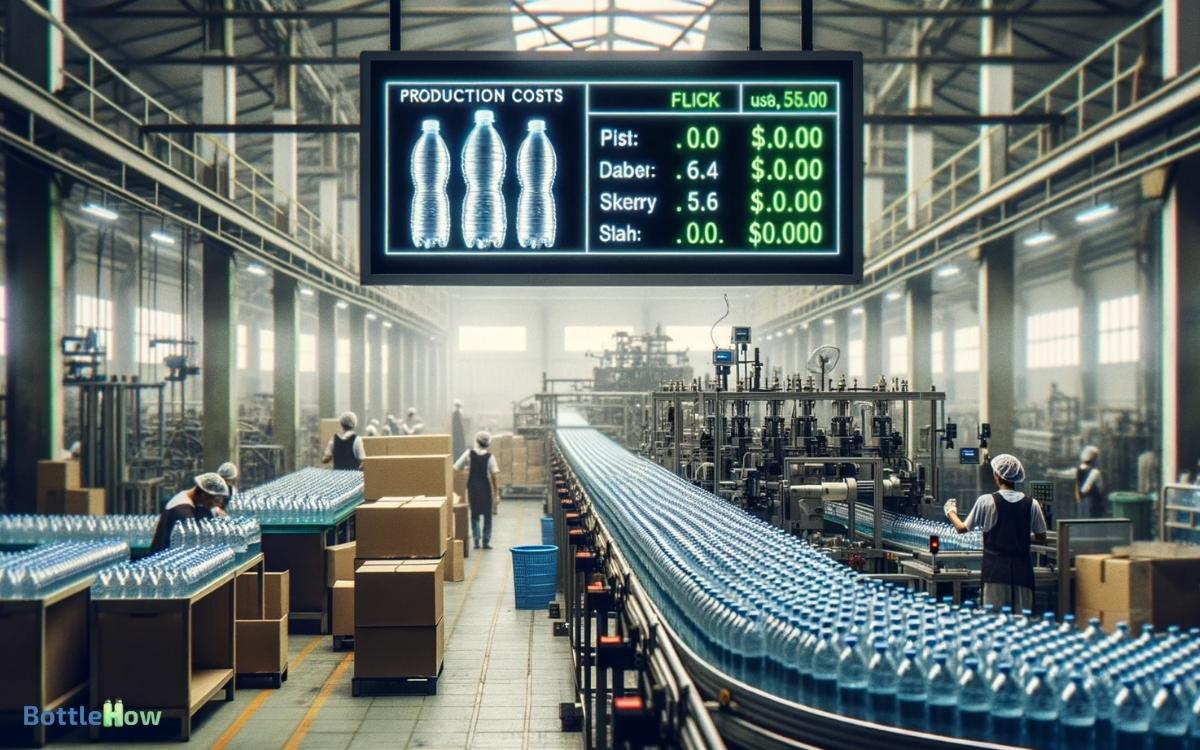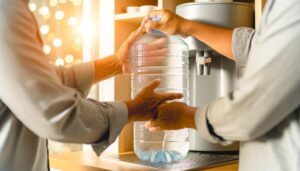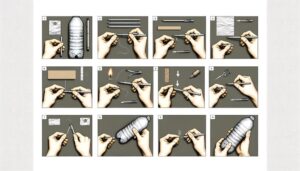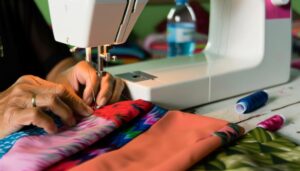How Much Does It Cost to Make a Water Bottle? Explained!
Creating a water bottle typically costs between $0.10 and $0.60 per unit, depending on materials and production methods.
Using PET plastic costs about $1.20 per kg, while HDPE costs $1.30 per kg. Additives like UV stabilizers add $0.01 to $0.02 per bottle.
Recycled plastics, such as rPET, can reduce raw material costs by up to 50%. Additionally, labor, packaging, transportation, and marketing collectively influence the final cost.
By using alternative materials like aluminum or glass, you might impact both costs and environmental footprint. To gain a deeper understanding of each cost component, let’s uncover more details.

Key Takeaways
Raw Materials
The primary raw materials for making a water bottle include polyethylene terephthalate (PET), high-density polyethylene (HDPE), and various additives that enhance durability and flexibility. These materials are chosen for their lightweight nature, strength, and resistance to impact, making them ideal for storing liquids safely. Additionally, recycled plastics are sometimes incorporated to reduce environmental impact and promote sustainability. In creative reuse, some individuals repurpose a water bottle as a neti pot for nasal irrigation, although this practice requires careful sterilization to ensure safety.
PET is a common choice due to its excellent strength-to-weight ratio and recyclability. It costs around $1.20 per kilogram, and a standard 500ml bottle uses approximately 25 grams, translating to about $0.03 per bottle.
HDPE offers superior resistance to impact and chemicals, costing roughly $1.30 per kilogram. Additives like colorants, UV stabilizers, and plasticizers further augment the material properties. These typically add $0.01 to $0.02 per bottle.
Understanding these costs helps you grasp the financial and material aspects of water bottle production, providing a clearer picture of the overall manufacturing expense.
Types of Plastic
When considering the types of plastic for water bottles, you’ll need to evaluate the benefits of PET plastic, which is lightweight and cost-effective. HDPE, while more durable, has higher production costs that impact overall expenses.
Utilizing recycled plastic can reduce material costs and environmental impact, but it requires evaluating the availability and quality of recycled sources.
PET Plastic Benefits
PET plastic offers numerous benefits, including its lightweight nature, recyclability, and cost-effectiveness, making it a popular choice for water bottle manufacturing.
You’ll find that PET (Polyethylene Terephthalate) is highly versatile and commonly used due to its strength and clarity.
This type of plastic is easy to mold, reducing production costs considerably. Its recyclability means you can use it multiple times, lessening environmental impact and waste.
| Benefit | Description | Impact on Cost |
|---|---|---|
| Lightweight | Easy to transport and handle | Reduces shipping costs |
| Recyclability | Can be reused multiple times | Lowers material costs |
| Cost-effective | Affordable to produce and mold | Minimizes production |
| Strength | Highly durable and strong | Extends lifespan |
| Clarity | Transparent and visually appealing | Enhances marketability |
Analyzing these benefits, it’s clear why PET plastic dominates the water bottle market.
HDPE Cost Factors
Regularly considered for its cost-efficiency, HDPE (High-Density Polyethylene) presents several key factors that influence its pricing in water bottle manufacturing. Understanding these factors helps you grasp the financial dynamics involved.
- Raw Material Costs: The price of crude oil profoundly impacts HDPE production costs.
- Manufacturing Efficiency: Improved production techniques can reduce waste and lower expenses.
- Market Demand: High demand for HDPE in various industries may drive prices up.
- Regulatory Compliance: Adhering to environmental and safety standards can add to costs.
These elements combine to shape the overall cost-effectiveness of using HDPE in water bottle production.
By analyzing these factors, you can make informed decisions about material choices and budgeting for your manufacturing processes.
Recycled Plastic Usage
Utilizing recycled plastics in water bottle manufacturing not only helps reduce environmental impact but also offers cost benefits and a variety of material options, including rPET, HDPE, and PP.
rPET, or recycled polyethylene terephthalate, is derived from post-consumer plastics and can lower raw material costs by up to 50%.
HDPE, or high-density polyethylene, offers durability and is often sourced from recycled milk jugs, reducing production expenses.
PP, or polypropylene, provides flexibility and is frequently recycled from automotive and packaging industries.
Alternative Materials
Exploring alternative materials for water bottles reveals a variety of options that can greatly impact both production costs and environmental footprint.
Analyzing these options can help you make informed decisions about sustainable practices and cost-efficiency.
Here are some notable alternatives:
- Aluminum: Highly recyclable with a lower environmental impact but involves higher initial production costs.
- Glass: Offers purity and reusability, though its weight and fragility can increase transportation and handling costs.
- Stainless Steel: Durable and long-lasting with minimal environmental impact, albeit with higher material costs.
- Biodegradable Plastics: Made from renewable resources, these reduce plastic waste but often come with higher production costs and limited recyclability.
Understanding these materials helps you weigh their financial implications and environmental benefits effectively.
Design and Prototyping
When initiating the design and prototyping phase for water bottles, you’ll need to incorporate both aesthetic considerations and functional requirements to guarantee market viability and user satisfaction.
Start by identifying target demographics and preferences through detailed market research.
Next, create digital 3D models using CAD software, which allows for precise visualization and adjustments.
Prototyping involves creating physical models using techniques like 3D printing or CNC machining.
Each prototype iteration helps identify design flaws and functional issues, reducing long-term costs. Consider factors such as ergonomics, durability, and ease of use.
Testing each prototype for leakage, temperature retention, and environmental impact is essential.
This thorough process ensures your final product meets high standards and aligns with market expectations.
Manufacturing Process
After refining your prototypes, you’ll move into the manufacturing process, which involves selecting materials, determining production methods, and setting up quality control measures.
To guarantee efficiency and cost-effectiveness, focus on:
- Material Selection: Choose between plastic, glass, or metal, considering cost, durability, and environmental impact.
- Production Methods: Decide on injection molding, blow molding, or another technique that aligns with your design and material choice.
- Quality Control: Implement checks at various stages to maintain consistency and meet regulatory standards.
- Supplier Partnerships: Establish relationships with reliable suppliers for raw materials and components.
Each decision in the manufacturing process directly impacts the overall cost. Analyzing these aspects meticulously will help you optimize production while maintaining high quality and minimizing expenses.
Machinery and Equipment
Investing in high-quality machinery and equipment is essential for optimizing production efficiency and minimizing long-term costs in water bottle manufacturing.
Key equipment includes blow molding machines, injection molding machines, and labeling systems.
Blow molding machines, costing between $50,000 and $200,000, shape the bottles from preforms. Injection molding machines, priced around $10,000 to $100,000, create the preforms themselves.
Labeling systems, ranging from $5,000 to $50,000, guarantee brand consistency and regulatory compliance.
Maintenance costs are important too, as regular servicing can extend machinery lifespan and reduce downtime.
Data shows that investing in advanced machinery reduces waste by up to 30% and boosts productivity by 20%.
Accurate cost analysis and meticulous equipment selection have a significant impact on your overall production budget.
Labor Costs
Beyond equipment costs, labor expenses significantly influence the overall cost of manufacturing water bottles. You need to take into account various categories of labor that impact this process.
- Direct Labor: This includes wages for employees directly involved in production, such as machine operators and assembly line workers.
- Indirect Labor: Costs for support staff, like maintenance workers and supervisors, who guarantee smooth operations.
- Administrative Labor: Salaries for administrative roles that oversee logistics, procurement, and other essential functions.
- Training Costs: Investment in training programs to make sure workers are skilled and efficient.
Quality Control
Quality control in water bottle manufacturing guarantees that each product meets stringent standards for safety, durability, and performance.
You need to understand that rigorous testing processes are essential. Inspections are conducted at multiple stages to make sure no flaws.
To give you a clear picture, here are some common quality control checks:
| Quality Check | Frequency | Importance Level |
|---|---|---|
| Material Inspection | Before production | High |
| Leak Testing | Post-production | Critical |
| Strength Testing | Random sampling | Medium |
| BPA Testing | Batch testing | High |
| Visual Inspection | Continuous | Moderate |
Investing in quality control can result in higher initial costs, but it minimizes defects and returns, ensuring customer satisfaction and long-term savings.
Packaging Expenses
Packaging expenses play a crucial role in the overall cost of making a water bottle, often accounting for a significant portion of the total production budget. You need to take into account several elements that contribute to these costs.
Key factors include:
- Material Costs: Plastic, glass, or aluminum have different price points.
- Labeling: Custom labels add to the expense, especially with intricate designs.
- Sealing and Caps: High-quality seals and caps guarantee product integrity but add to the cost.
- Compliance: Packaging must meet regulatory standards, which can vary by region and increase costs.
Transportation and Shipping
Transportation and shipping expenses can greatly impact the overall cost structure of producing a water bottle. These expenses encompass fuel costs, logistics, and handling fees.
You’ll need to account for the distance between the manufacturing plant and distribution centers. Longer distances increase fuel consumption, directly raising costs.
Efficient logistics, such as optimized routes and load management, can mitigate some expenses. Handling fees, including loading and unloading at various transit points, add another layer of costs.
Data shows that transportation and shipping can account for up to 15% of the total production cost.
Understanding these factors helps you identify potential savings and streamline your supply chain. This ensures your water bottle remains competitively priced without compromising on quality.
Marketing and Branding
Investing in marketing and branding strategies is vital, as these efforts can greatly impact consumer perception and drive up to 30% of the product’s retail price.
You’ll need to contemplate various factors that contribute to these costs:
- Advertising Campaigns: Expenses for digital, print, and social media ads.
- Packaging Design: Costs associated with creating an appealing, distinctive design.
- Brand Development: Fees for developing a strong brand identity, including logos and slogans.
- Promotional Activities: Costs for events, sponsorships, and influencer partnerships.
Each of these elements plays an essential role in differentiating your water bottle from competitors.
Environmental Impact
Examining the environmental impact of producing a water bottle requires a detailed analysis of the entire lifecycle, from raw material extraction to disposal.
First, consider the energy and resources needed to extract petroleum for plastic bottles. Studies show this process emits approximately 2.5 kg of CO2 per kilogram of plastic.
Next, manufacturing involves further energy consumption and chemical usage, adding to the carbon footprint. Transportation of these bottles contributes as well, with emissions varying based on distance.
Conclusion
To sum up, when you factor in raw materials, design, manufacturing, packaging, shipping, and marketing, the cost of making a water bottle isn’t just pennies—it’s a whole mountain of considerations.
By analyzing each component, you can better understand the complexities and true cost behind that simple bottle. From types of plastic to environmental impacts, every detail counts.
So next time you grab a water bottle, remember, it’s not just water—it’s a marvel of modern engineering.





